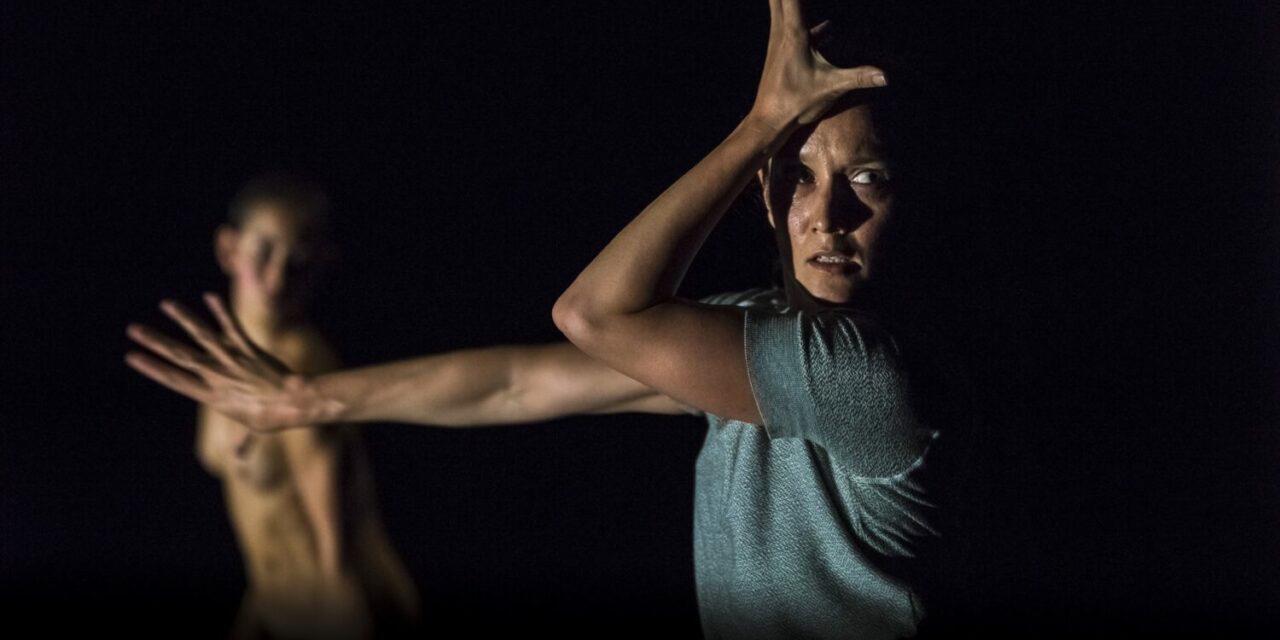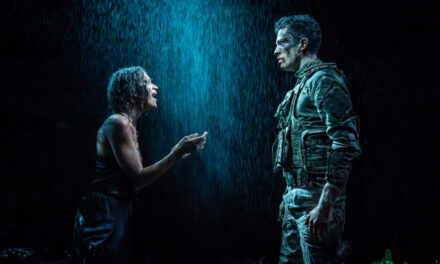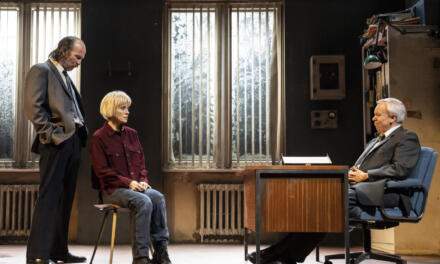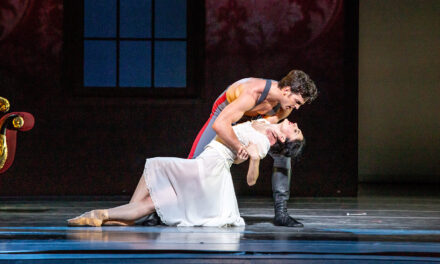Lucy Guerin is one of the most innovative, postmodern choreographers on the contemporary dance scene. Throughout the past twenty years, the Australian choreographer has been given many accolades for her work, including a Bessie. The British audience might remember Guerin’s name from her foray into the field of theatre (collaborations with director Carrie Cracknell in Medea at the National Theatre in 2014 and in Macbeth at the Young Vic in 2015), her hilarious Untrained (presenting two untrained dancers alongside two professionals), as well as her 2016 commission for Rambert (Tomorrow). This time it was Guerin’s 2017 work, Split that was shown at The Place in London, as part of the Dance Umbrella Festival 2019.
Split is a duet for two female dancers, one in a dress and another nude, dancing to pulsating, repetitive, electronic music in a diminishing space, in nine scenes decreasing in duration.
The performance starts with the two dancers standing next to each other, and responding to the ostinato beat of the electronic percussion music, (composed by British artist Scanner aka Robin Rimbaud), moving in synchronicity. The two bodies pulsate, swing, sway, and travel to the beat of the music – almost to the point of exhaustion.
Two things frame the repetitive, energetic flow of the dancers’ movements: the eight beats of the music and a rectangle on the dance floor marked up with thick, white gaffer tape. From time to time, the dancers stop, leave the rectangle of the dancing area, and with a white marking tape bisect their space. Moving onto one half, and limited to that smaller space, the dance continues, until the section ends (which is half the duration of the previous one); the dancers fetch the tape and split the dance floor again, and this pattern continues until they run out of space.
During these shorter and shorter scenes, we see a departure from the harmony of the unison, and different relationships develop between these bodies – variations on interconnectedness and conflict. A power battle evolves between the two sides. How do those bodies negotiate the diminishing space, how powerful or vulnerable are they, and can they ultimately find harmony – the choreography asks many questions on many levels. It is an intriguing dance piece, rich in layers of meaning.
For the first, and longest part, there is no interaction between the two dancers: their faces are neutral, only the synchronicity of their movements connects them. Near the end of the first scene, they drop to the ground, and between heavy pauses, the ostinato dance ‘chorus’ continues, but somehow the consonance between these bodies becomes corrupted and labored. Once the space is halved, the unity is broken, and instead, interaction develops between the dancers: they respond to each other, challenge each other, and fight for dominance, whilst contained in a diminishing space.
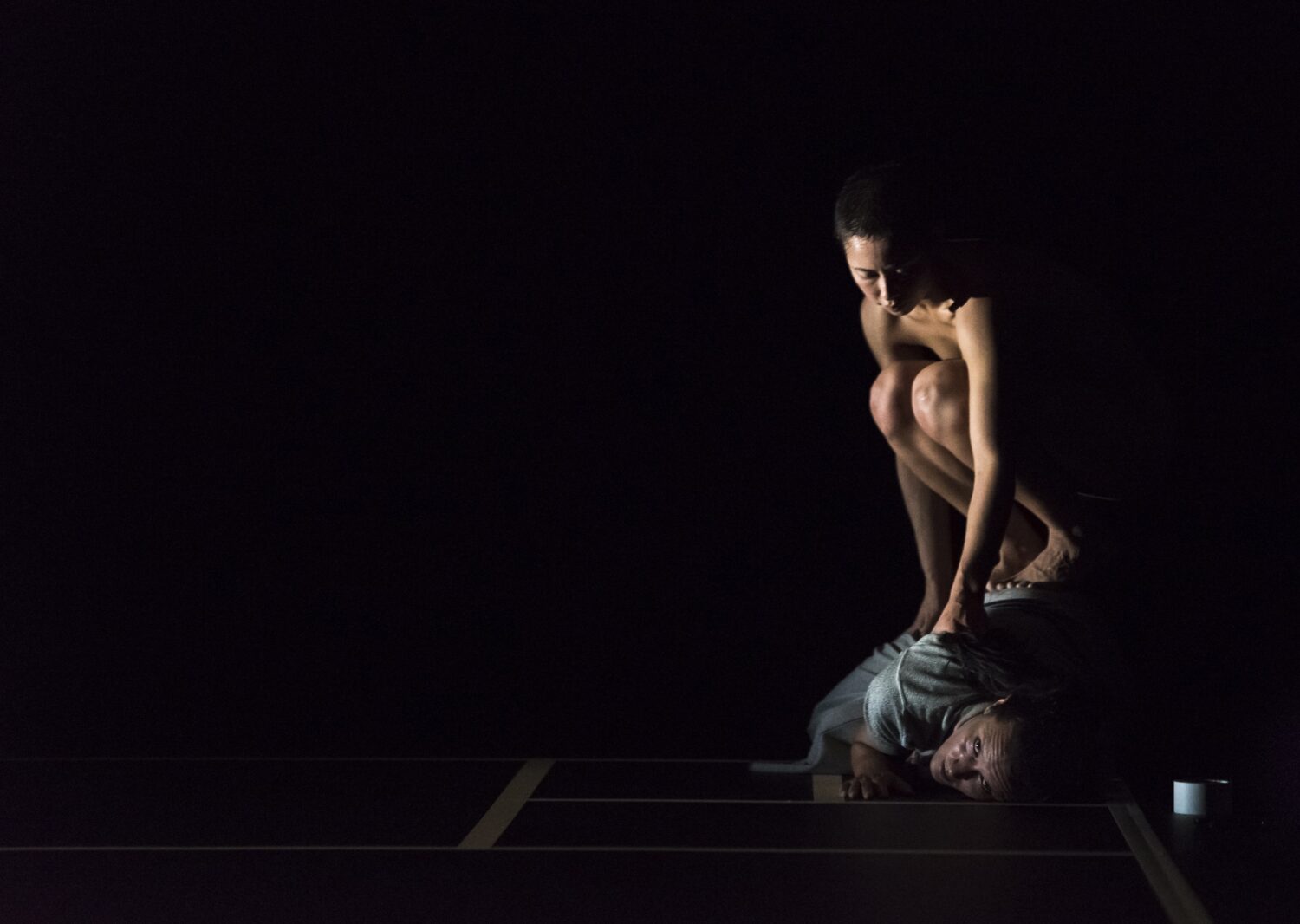
Photo credit: Gregory Lorenzutti.
Each split is pushing the dancers into a smaller floor surface to use, until they are unable to travel, and are immobilized in a corner in upstage right, where the marked-up floor is barely enough for two pairs of feet to stand on. The nude is standing closely behind the dressed woman, the two bodies with arms stretched up high are like each other’s shadows. They only perform one movement: bending slowly backward, blending into each other as one.
During the performance from those split rectangles, the dancers drew a Fibonacci-like shape onto the dance floor with the white masking tape. It suggests the journey was inwards: through the duration of the piece we spiraled deeply into an inner world to witness the antagonism between primeval and civilized, subconscious and conscious, anima and animus, etc. – the choice is up to the viewer.
The dancers are excellent. Especially Lilian Steiner, who wears her nudity with poise and confidence. Her body is unabashedly female, yet her nudity is deprived of any sexual connotations: it is a beautiful human form, bursting with energy, and it is also the place where her gestures are realized with vigor and beauty. Steiner’s movements are graceful yet strong, powerful, mesmerizing to watch. Whereas Ashley McLellan’s movements have a slightly rough, urban quality – thus even in the synchronicity of these two dancers’ gestures, we can see two distinctively different characters.
The concept is simple and easy to understand, but it is intricate and complex in its simplicity. There is something tribal and hypnotic about the piece. The movement vocabulary for most of the show is idiosyncratically Guerin’s own: fresh, energetic, athletic yet elegant and beautiful.
What leaves me with slight dissatisfaction is that after the dance floor is divided, Guerin can’t resist the temptation of explaining what the splitting of the space, time, and individual might convey. At these times, in the shorter scenes (especially in the second one), the movement vocabulary changes, and often shrinks to commonplace gestures and pantomime. This spoils the work somewhat, and makes it unnecessarily demonstrative; leaving the viewer disappointed with Guerin’s choice of not using less clichédlanguage to convey the same thoughts, feelings, and expressions when showing the ‘primeval’ side. It is a shame, since Guerin’s work speaks volumes without explanation. Split (even with its imperfections) will definitely be remembered as one of Guerin’s classics.
This post was written by the author in their personal capacity.The opinions expressed in this article are the author’s own and do not reflect the view of The Theatre Times, their staff or collaborators.
This post was written by Katalin Trencsényi.
The views expressed here belong to the author and do not necessarily reflect our views and opinions.

